|
Arctic Ozone Depletion in 2000 - Click here for animation of the development of the ozone "hole." Caption for Image 1: The Arctic Ozone "Hole" The blue colors in this sequence depict the depleted region of ozone over the North Pole that occurred in the winter of 2000. Though ozone "holes" appear each year over the South Pole, low levels of ozone only occasionally form over the northern polar regions during very cold winters. Scientists say the northern ozone hole may reappear for several consecutive years after a period of high volcanic activity. A northern ozone hole could be significant because more people live in Arctic regions than near the South Pole. The data for these images were collected by the Total Ozone Mapping Spectrometer (TOMS) satellite. |
An "ozone hole" could form over the North Pole after future major volcanic eruptions, according to the cover story by a NASA scientist in tomorrow's edition of the Proceedings of the National Academy of Sciences.
Since the 1980s a seasonal ozone hole, characterized by severe loss of ozone, has appeared over the continent of Antarctica. However, scientists have not yet observed, on an annual basis, as severe a thinning of the protective ozone layer in the atmosphere over the Arctic. The ozone layer shields life on Earth from harmful ultraviolet radiation. A northern ozone hole could be significant since more people live in Arctic regions than near the South Pole.
|
Click
here for an animation of the sequence of events
for these five stills.
Caption for Images 2-6: Volcanic Plume Spreads This computer model shows the dispersion of the volcanic plume from the Mt. Pinatubo volcano. The 1991 Pinatubo eruption was sulfur-rich, producing volcanic clouds that lasted a number of years in the stratosphere. The Pinatubo eruption widely expanded the area of ozone loss over the Arctic and Antarctic. Red colors indicate higher elevations and blue colors indicate lower elevations for the plume. The high resolution pictures below are all 11 MB in size. High
res of Image 2 |
"A 'volcanic ozone hole' is likely to occur over the Arctic within the next 30 years," said Azadeh Tabazadeh, lead author of the paper and a scientist at NASA's Ames Research Center, Moffett Field, Calif. Her co-authors are: Katja Drdla, also of Ames; Mark R. Schoeberl of NASA's Goddard Space Flight Center, Greenbelt, Md.; Patrick Hamill of San Jose State University, Calif.; and O. Brian Toon from the University of Colorado, Boulder.
"If a period of high volcanic activity coincides with a series of cold Arctic winters, then a springtime Arctic ozone hole may reappear for a number of consecutive years, resembling the pattern seen in the Antarctic every spring since the 1980s," Tabazadeh said.
|
|
TOMS Satellite -Click here for animation of the TOMS satellite. Caption for Image 7: TOMS Satellite The Total Ozone Mapping Spectrometer is continuing NASA's long term daily mapping of the global distribution of the Earth's atmospheric ozone. In addition to ozone, however, TOMS measures sulfur dioxide released in volcanic eruptions. |
"Unlike the Antarctic where it is cold every winter, the winter in the Arctic stratosphere is highly variable," Tabazadeh said. NASA satellite and airborne observations show that significant Arctic ozone loss occurs only following very cold winters, according to Tabazadeh.
Large volcanic eruptions pump sulfur compounds into the Earth's atmosphere. These compounds form sulfuric acid clouds similar to polar stratospheric clouds made of nitric acid and water. The clouds of nitric acid and water form in the upper atmosphere during very cold conditions and play a major part in the destruction of ozone over Earth's poles. Following eruptions, volcanic sulfuric acid clouds would greatly add to the ozone-destroying power of polar stratospheric clouds, researchers said.
"Volcanic aerosols also can cause ozone destruction at warmer temperatures than polar stratospheric clouds, and this would expand the area of ozone destruction over more populated areas," Tabazadeh said. "Nearly one-third of the total ozone depletion could be a result of volcanic aerosol effects at altitudes below about 17 kilometers (11.5 miles)," said the researchers.
"Volcanic emissions can spread worldwide," said Schoeberl. "Our Mt. Pinatubo computer simulation shows that the volcanic plume spread as far north as the North Pole in the lowest part of the stratosphere within a few months after the eruption."
Between about 15 and 25 kilometers (9 to 16 miles) in altitude, volcanic Arctic clouds could increase springtime ozone loss over the Arctic by as much as 70 percent, according to Drdla. "The combination of thick volcanic aerosols at lower altitudes and natural polar stratospheric clouds at higher altitudes could greatly increase the potential for ozone destruction over the North Pole in a cold year," Tabazadeh said.
"Both the 1982 El Chichon and 1991 Mt. Pinatubo eruptions were sulfur-rich, producing volcanic clouds that lasted a number of years in the stratosphere," Tabazadeh said. The Pinatubo eruption, as observed by NASA spacecraft, widely expanded the area of ozone loss over the Arctic.
Both of these eruptions did have an effect, however, over the South Pole, expanding the area and the depth of the ozone hole over the Antarctic, according to Tabazadeh. Computer simulations have shown that the early and rapid growth of the Antarctic ozone hole in the early 1980s may have been influenced in part by a number of large volcanic eruptions, she added.
"In 1993 the Arctic winter was not one of the coldest winters on record, and yet the ozone loss was one of the greatest that we've seen," Tabazadeh said. "This was due to the sulfurous Pinatubo clouds facilitating the destruction of additional ozone at lower altitudes where polar stratospheric clouds cannot form."
"Climate change combined with aftereffects of large volcanic eruptions will contribute to more ozone loss over both poles," Tabazadeh said. "This research proves that ozone recovery is more complex than originally thought."
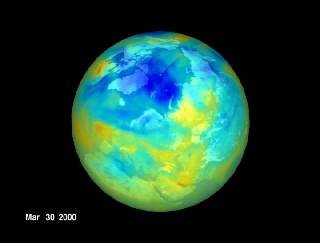
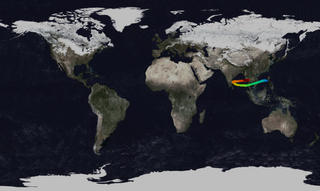
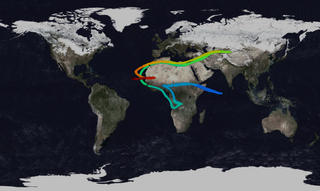
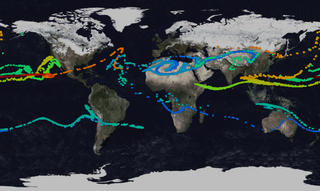
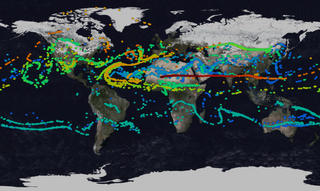
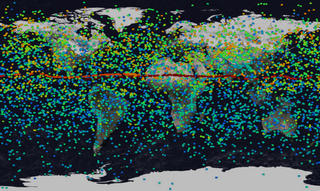
 Image 7
Image 7